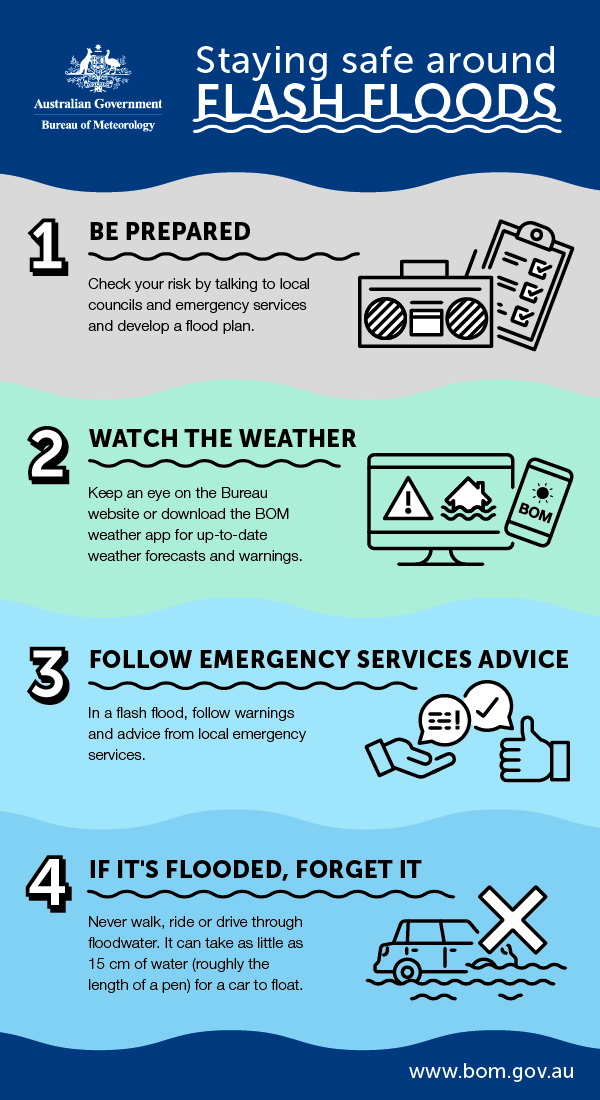Flash Floods: Understanding The Risks And How To Stay Safe

Table of Contents
Understanding the Risks of Flash Floods
Geographic Locations Prone to Flash Floods
Certain geographic locations are inherently more susceptible to flash floods than others. These high-risk areas often share common characteristics that contribute to their vulnerability. Understanding these factors is the first step in mitigating the risk.
- Floodplains: Low-lying areas adjacent to rivers and streams are particularly vulnerable to flash flooding, as they are the natural pathways for overflowing water.
- Mountainous Terrain: Steep slopes and canyons in mountainous regions can channel intense rainfall rapidly downhill, leading to sudden and powerful surges of water.
- Arid and Semi-arid Regions: While seemingly unlikely, desert areas can experience flash floods due to infrequent but intense rainfall events, coupled with the hard, impermeable ground that prevents water absorption.
- Areas with Inadequate Drainage Systems: Urban areas and communities with poorly maintained or inadequate drainage infrastructure are at greater risk, as water cannot be effectively channeled away.
Examples of specific flash flood prone regions include the mountainous areas of the Himalayas, the desert regions of Arizona, and many coastal areas prone to intense rainfall. These areas are vulnerable due to factors like intense rainfall in short periods, rapid runoff, and lack of vegetation to absorb the water.
Identifying Flash Flood Warning Signs
Recognizing the early warning signs of a flash flood is critical to ensuring your safety. These signs can range from subtle changes in weather patterns to obvious visual cues indicating imminent danger. Staying informed and vigilant is key.
- Heavy Rainfall: Prolonged or intense rainfall, especially in short durations, is a primary indicator. Pay close attention to weather forecasts and warnings.
- Rapidly Rising Water Levels: Observe streams, rivers, and normally dry areas. A sudden and significant increase in water levels is a clear warning sign.
- Overflowing Rivers or Streams: When water levels exceed the banks of rivers or streams, it indicates a high risk of flash flooding in nearby areas.
- Sudden Changes in Water Color: A change in water color, often becoming muddy or brown, suggests that sediment and debris are being carried downstream, a sign of increased water flow.
- Strong Currents: Noticeably strong and fast-moving currents in water bodies are a significant indicator of dangerous flood conditions.
It is crucial to interpret weather forecasts and warnings issued by meteorological agencies and local authorities seriously. Heed any evacuation orders immediately.
The Impact of Flash Floods
The consequences of flash floods can be catastrophic, impacting lives, property, and the economy on a large scale. The destructive power of these events underscores the importance of preparedness and prevention.
- Property Damage: Homes, businesses, and infrastructure can be completely destroyed or severely damaged. Flooding can undermine foundations and cause structural collapse.
- Loss of Life: Flash floods are responsible for numerous fatalities each year, often due to drowning or being swept away by strong currents.
- Infrastructure Damage: Roads, bridges, and utility lines are often severely damaged or destroyed, disrupting essential services and hampering rescue efforts.
- Economic Impact: The cost of repairing damage, rebuilding infrastructure, and dealing with the aftermath of a flash flood can be immense, significantly impacting local and national economies.
- Contamination of Water Supplies: Floodwaters often contaminate water sources with sewage, chemicals, and debris, posing serious health risks.
Past flash flood disasters across the globe serve as stark reminders of the devastating potential of these events, highlighting the need for comprehensive mitigation strategies.
Staying Safe During and After a Flash Flood
Actions to Take During a Flash Flood
Having a well-defined emergency plan is essential for mitigating the risks associated with flash floods. Swift action can save lives.
- Evacuation: If you receive a flash flood warning or notice rising water levels, evacuate immediately to higher ground. Familiarize yourself with designated evacuation routes in advance.
- Seek Shelter: If evacuation isn't immediately possible, move to the highest level of a sturdy building and stay away from windows.
- Avoid Driving Through Floodwaters: Never attempt to drive or walk through floodwaters, as even shallow water can be deceptively dangerous and sweep away vehicles.
- Turn Off Utilities: Switch off electricity and gas to prevent electrical shocks and potential fires.
- Monitor Conditions: Stay informed about the developing situation by listening to the radio or watching television for updates.
Post-Flash Flood Safety Procedures
Even after the immediate floodwaters recede, significant dangers persist. Caution and awareness remain crucial during the post-flood recovery phase.
- Avoid Contaminated Water: Floodwaters are often contaminated with sewage, chemicals, and debris. Avoid contact with floodwater, and ensure that drinking water is safe.
- Assess Structural Damage: Before returning to your home, have it inspected for structural damage by a qualified professional.
- Careful Cleanup Process: Use appropriate safety gear and follow health guidelines when cleaning up flood damage to prevent injury and disease.
- Do Not Return Home Until Authorities Declare it Safe: Wait for official clearance before returning to your home or property to avoid further risks.
Conclusion
Flash floods are unpredictable and extremely dangerous natural disasters. Understanding the risks associated with these events and implementing appropriate safety measures are crucial for protecting lives and property. By being aware of high-risk areas, recognizing warning signs, and following safety protocols during and after a flash flood, you can significantly reduce your vulnerability. Develop your personal flash flood preparedness plan today, including evacuation routes, emergency contact information, and a supply kit, to ensure your family’s safety and increase your chances of surviving a flash flood. By actively participating in flash flood preparedness, you can safeguard your community and mitigate the impacts of this devastating natural phenomenon. Stay safe during flash floods!

Featured Posts
-
 Follow The F1 Action Live Monaco Grand Prix Timing Data
May 26, 2025
Follow The F1 Action Live Monaco Grand Prix Timing Data
May 26, 2025 -
 Paris Roubaix Bottle Throwing Spectator Turns Himself In
May 26, 2025
Paris Roubaix Bottle Throwing Spectator Turns Himself In
May 26, 2025 -
 Explorer La Vie Des Gens D Ici
May 26, 2025
Explorer La Vie Des Gens D Ici
May 26, 2025 -
 Canli Izle Atletico Madrid Barcelona Macinin Canli Yayini Fanatik Te
May 26, 2025
Canli Izle Atletico Madrid Barcelona Macinin Canli Yayini Fanatik Te
May 26, 2025 -
 The Turning Point George Russells Solution To Mercedes Performance Issue
May 26, 2025
The Turning Point George Russells Solution To Mercedes Performance Issue
May 26, 2025
Latest Posts
-
 French Open 2024 Surprise Defeats For Ruud And Tsitsipas Swiatek Triumphs
May 30, 2025
French Open 2024 Surprise Defeats For Ruud And Tsitsipas Swiatek Triumphs
May 30, 2025 -
 Roland Garros 2024 Ruud And Tsitsipas Early Losses Swiateks Continued Success
May 30, 2025
Roland Garros 2024 Ruud And Tsitsipas Early Losses Swiateks Continued Success
May 30, 2025 -
 Early French Open Exits For Ruud And Tsitsipas Swiateks Strong Start
May 30, 2025
Early French Open Exits For Ruud And Tsitsipas Swiateks Strong Start
May 30, 2025 -
 French Open Upsets Ruud And Tsitsipas Exit Early Swiatek Dominates
May 30, 2025
French Open Upsets Ruud And Tsitsipas Exit Early Swiatek Dominates
May 30, 2025 -
 French Open Sinner And Djokovic Face Tough Competition
May 30, 2025
French Open Sinner And Djokovic Face Tough Competition
May 30, 2025
